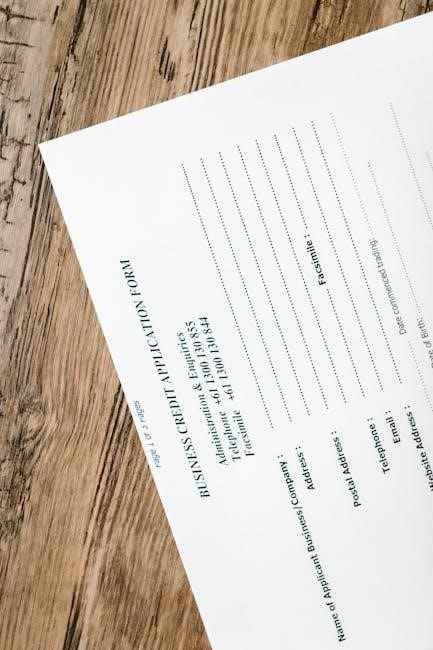Form 8802 is used to request a certificate of residency (Form 6166) for claiming tax treaty benefits or VAT exemptions‚ essential for U․S․ residents․
1․1 Purpose of Form 8802
Form 8802 is designed to enable individuals and entities to obtain a U․S․ residency certification‚ formally known as Form 6166․ This certification is essential for claiming benefits under income tax treaties or value-added tax (VAT) exemptions․ The primary purpose of the form is to verify the applicant’s U․S․ residency status for tax purposes‚ ensuring compliance with international tax agreements․ By submitting Form 8802‚ applicants can demonstrate their eligibility to receive reduced withholding rates or exemptions as outlined in applicable tax treaties․ This process simplifies cross-border tax matters and helps prevent double taxation‚ making it a crucial document for individuals and businesses engaged in international transactions․
1․2 Importance of Form 8802 for Tax Treaty Benefits
Form 8802 plays a critical role in facilitating compliance with international tax agreements by providing the necessary certification for tax treaty benefits․ It enables U․S․ residents to claim reduced withholding rates or exemptions under applicable tax treaties‚ preventing double taxation․ This certification is essential for individuals and businesses engaged in cross-border transactions‚ as it validates their U․S․ residency status for tax purposes․ By obtaining Form 6166 through Form 8802‚ applicants can ensure they meet the requirements to avail treaty benefits‚ streamline tax compliance‚ and avoid additional tax liabilities․ This process is vital for maintaining accurate and efficient international tax reporting․

Eligibility Criteria for Form 8802
Form 8802 is for U․S․ residents‚ including individuals and entities‚ to apply for residency certification‚ ensuring they meet the necessary requirements for tax treaty benefits eligibility․
2․1 Who Can Apply for U․S․ Residency Certification
U․S․ citizens‚ resident aliens‚ and certain businesses or entities may apply for residency certification using Form 8802․ Applicants must meet specific residency requirements under U․S․ tax law․ This includes individuals with a valid Social Security Number (SSN) or Individual Taxpayer Identification Number (ITIN) and businesses operating within the U․S․ The certification is essential for claiming tax treaty benefits or VAT exemptions․ Applicants must demonstrate they meet the U․S․ residency criteria for the tax year in question․ This process ensures compliance with IRS regulations and verifies eligibility for treaty-based tax relief․ Proper documentation and meeting all requirements are crucial for a successful application․
2․2 Residency Requirements for Certification
To qualify for U․S․ residency certification‚ applicants must meet specific criteria under U․S․ tax law․ Residency is typically determined by factors such as domicile‚ tax home‚ and physical presence in the U․S․ Individuals or entities must demonstrate that the U․S․ is their primary residence for tax purposes․ This may involve showing ties to the U․S․‚ such as filing a U․S․ tax return‚ maintaining a business presence‚ or meeting substantial presence tests․ The IRS evaluates residency based on these factors to ensure applicants meet the legal standards for certification․ Proper documentation and evidence of residency are critical to satisfy the requirements and obtain Form 6166․

Application Process for Form 8802
The Form 8802 application process involves completing the form with accurate information‚ calculating the required fee‚ and submitting it with necessary documentation․
3․1 Steps to Complete Form 8802
To complete Form 8802‚ start by accurately filling in the applicant’s name‚ TIN‚ address‚ and the tax period(s) for which certification is requested․ Calculate the user fee based on the applicant type‚ ensuring the correct payment method is chosen (e․g․‚ check‚ money order‚ or electronic payment via Pay․gov)․ Attach all required documentation‚ including identification‚ proof of residency‚ and tax-related documents․ If certification is for the current year or a year where a tax return isn’t yet filed‚ include a penalties-of-perjury statement from Table 2 of the instructions․ Review the form for completeness and accuracy before submission to avoid delays or rejection․
3․2 Required Information and Documentation
To complete Form 8802‚ applicants must provide specific information and documentation․ This includes identification documents‚ such as a valid U․S․ passport or state-issued ID‚ and proof of residency‚ like utility bills or bank statements․ Tax-related documentation‚ such as a signed copy of the current-year income tax return‚ may also be required․ If certification is for the current calendar year or a year for which a tax return isn’t yet filed‚ a penalties-of-perjury statement from Table 2 of the instructions must be included․ All submissions must ensure accuracy and completeness to avoid processing delays or rejections by the IRS․ Proper documentation is critical for successful certification․
3․3 Submitting the Application
Once Form 8802 is completed and all required documentation is gathered‚ applicants must submit the application with the appropriate user fee․ The application‚ fee‚ and attachments should be mailed to the Department of the Treasury‚ Internal Revenue Service in Philadelphia‚ PA 19255-0625․ Alternatively‚ private delivery services can be used to send the application to Internal Revenue Service‚ 2970 Market Street‚ Philadelphia‚ PA 19104․ Payments can be made via check‚ money order‚ or electronic payment through Pay․gov․ The user fee for individual applicants is $85‚ regardless of the number of countries for which certification is requested․ Ensure all submissions are accurate and complete to avoid delays․ Always refer to the latest IRS instructions for updates․

Required Documents for Form 8802
Submit identification‚ proof of residency‚ and tax-related documentation to complete the application process for Form 8802 accurately and efficiently․
4․1 Identification Documents
Applicants must provide valid identification documents to verify their identity․ For individuals‚ this includes a passport‚ national ID card‚ or state-issued ID․ For businesses‚ corporate documents like articles of incorporation or a business license are required․ Ensure all documents are current and not expired․ Additional proof‚ such as a government-issued ID with a photo‚ may be requested․ These documents are essential for processing the residency certification․ Failure to provide valid identification may delay the application․ Always check the latest IRS guidelines for specific requirements․ Proper identification ensures compliance with tax regulations and facilitates the certification process․ Submission of authentic documents is mandatory for a smooth application experience․
4․2 Proof of Residency
Applicants must submit documentation to establish their U․S․ residency․ Acceptable documents include a valid U․S․ passport‚ utility bills‚ lease agreements‚ bank statements‚ or employment letters․ These documents must clearly show the applicant’s name and U․S․ address․ Utility bills and bank statements should be dated within the last six months․ For non-individual applicants‚ such as businesses‚ proof of a U․S․ business address is required․ The IRS may request additional documentation if the submitted proofs are insufficient․ Ensure all documents are valid and current to avoid delays in processing․ Proper proof of residency is critical for certification eligibility․ Failure to provide adequate documentation may result in rejection of the application․
4․3 Tax-Related Documentation
Applicants must provide tax-related documents to support their Form 8802 application․ This includes a signed copy of their current year’s U․S․ income tax return (Form 1040 for individuals or Form 1120 for corporations)․ If the return has not been filed yet‚ a penalty of perjury statement from the instructions must be included․ For ITIN applicants‚ Form W-7 must accompany the submission․ Additional documentation‚ such as Schedule C for self-employed individuals or Form 1120 for corporations‚ may be required․ Ensure all tax-related documents are complete and accurate to avoid processing delays․ Failure to provide required tax documentation may result in the rejection of the application․ Proper tax documentation is essential for verifying eligibility for residency certification․

User Fee for Form 8802
The user fee for Form 8802 is $85 per applicant‚ regardless of the number of countries․ Payment can be made by check‚ money order‚ or electronically via Pay․gov․
5․1 Fee Structure
The user fee for Form 8802 is currently set at $85 per applicant‚ applicable to both individuals and entities․ This fee is non-refundable and must be paid regardless of the number of countries for which certification is requested․ The fee structure remains the same for all applicants‚ ensuring a uniform cost for processing residency certification requests․ It is essential to note that this fee does not include additional costs that may arise during the certification process․ Applicants should ensure they meet all eligibility criteria before submitting the fee‚ as it cannot be refunded once the application is processed․ The fee is subject to change‚ so it is advisable to verify the latest updates on the IRS website or consult the form’s instructions for confirmation․
5․2 Payment Methods
Payment for Form 8802 can be made via check‚ money order‚ or electronic payment through Pay․gov․ Checks and money orders must be drawn on a U․S․ financial institution and made payable to the “United States Treasury․” Cash payments are not accepted․ Electronic payments via Pay․gov are a convenient option‚ offering immediate confirmation of payment․ Ensure the payment method includes the applicant’s name‚ TIN‚ and “Form 8802” to avoid delays․ A payment confirmation will be provided upon successful submission․ Keep this confirmation for your records‚ as it serves as proof of payment․ The IRS does not accept foreign currency or other forms of payment for this application․

Processing Time for Form 8802
The IRS typically processes Form 8802 within 4-6 weeks․ Expedited options are available for an additional fee‚ reducing processing time to 2-3 weeks․
6․1 Expected Timeline
The IRS processes Form 8802 within 4-6 weeks under normal circumstances․ Applications postmarked by October 2 meet the effective date for the next calendar year․ Expedited options are available for an additional fee‚ reducing processing time to 2-3 weeks․ The user fee for individual applicants is $85‚ regardless of the number of countries for certification․ Ensuring all required documentation and correct payment accompanies the application helps avoid delays․ Applicants should plan accordingly‚ especially for time-sensitive tax treaty benefits or VAT exemptions․ Proper submission and adherence to guidelines ensure timely processing and issuance of the residency certification․
6․2 Expedited Processing Options
For an additional fee‚ the IRS offers expedited processing of Form 8802‚ reducing the processing time to approximately 2-3 weeks․ This option is ideal for applicants requiring timely certification for tax treaty benefits or VAT exemptions․ The user fee for expedited processing is not specified but must accompany the application․ Applicants can pay via check‚ money order‚ or electronic payment through Pay․gov․ Ensuring all required documentation is complete and accurate is crucial to avoid delays․ Expedited processing helps applicants meet deadlines for foreign tax authorities‚ ensuring uninterrupted access to treaty benefits․ Proper submission and payment methods are detailed in the IRS instructions for Form 8802․

Required Forms and Attachments
Form 6166 is the primary attachment for residency certification․ Additional forms may include a signed tax return or penalties of perjury statement if required by the IRS․
7․1 Form 6166 (Letter of U․S․ Residency Certification)
Form 6166 is a letter of U․S․ residency certification issued by the IRS‚ confirming an individual’s or entity’s residency for tax treaty purposes․ It is requested by submitting Form 8802․ This certification is essential for claiming benefits under income tax treaties or VAT exemptions․ The letter verifies the applicant’s status as a U․S․ resident for the specified tax period․ Form 6166 cannot be used to substantiate U․S․ taxes paid for foreign tax credit claims․ It is a critical document for taxpayers seeking to avail themselves of treaty benefits‚ ensuring compliance with international tax agreements․ The certification process involves submitting required documentation and meeting IRS criteria․
7․2 Additional Forms and Schedules
Beyond Form 6166‚ applicants may need to submit additional forms and schedules to complete their request․ For instance‚ Form W-7 is required for obtaining an ITIN‚ while Form SS-4 is necessary for entities applying for an EIN․ These forms ensure proper identification and eligibility verification․ Schedules may include detailed income statements or tax period specifications‚ depending on the applicant’s circumstances․ It is crucial to review the instructions for each form to ensure accuracy and avoid delays․ Failure to include required schedules or forms may result in processing delays or rejection of the application․ Always refer to the IRS website for the most current versions of these documents and their instructions․

Submission Guidelines
Submit Form 8802 to the IRS at the specified mailing address or electronically through approved methods․ Ensure all required documents and fees are included for timely processing․
8․1 Mailing Address
Applications for Form 8802 must be mailed to the Department of the Treasury‚ Internal Revenue Service‚ Philadelphia‚ PA 19255-0625․ For private delivery services‚ use Internal Revenue Service‚ 2970 Market Street‚ Philadelphia‚ PA 19104․ Ensure the correct mailing address is used to avoid processing delays․ Include the completed Form 8802‚ required documentation‚ and the appropriate user fee․ Use a trackable shipping method for confirmation․ The IRS does not accept applications via email or fax․ Mailing addresses and submission guidelines are detailed in the official IRS instructions for Form 8802․ Always verify the most current address before mailing to ensure timely processing․
8․2 Electronic Submission Options
As of September 29‚ 2024‚ the IRS introduced an electronic submission option for Form 8802 through Pay․gov․ Applicants can now upload their completed Form 8802‚ supporting documents‚ and pay the user fee online․ This method expedites processing and reduces mailing time․ Visit the IRS website at IRS․gov and navigate to the Form 8802 page for detailed instructions․ Ensure all required documents‚ such as proof of residency and tax-related forms‚ are scanned and attached․ The electronic submission option streamlines the application process‚ making it more efficient and convenient for applicants․ Payment confirmation and submission receipts are provided electronically for record-keeping purposes․

Penalties and Compliance
Incomplete or late submissions of Form 8802 may result in processing delays or penalties․ Ensure compliance with IRS regulations to avoid noncompliance issues and ensure timely processing of your application․
9․1 Consequences of Late or Incomplete Applications
Failing to submit Form 8802 on time or with missing information can lead to processing delays or rejection․ Incomplete applications may require resubmission‚ causing extended wait times․ Late submissions might result in penalties or forfeiting tax treaty benefits․ Ensure all required fields‚ documentation‚ and fees are included to avoid complications․ Double-checking the application for accuracy and completeness is crucial to prevent setbacks․ Delays may impact tax filings or treaty benefit claims‚ potentially increasing tax liabilities․ Timely and accurate submission is essential to maintaining compliance and avoiding unnecessary penalties or disruptions in certification processes․
9․2 Compliance with IRS Regulations
Compliance with IRS regulations is crucial when filing Form 8802․ Applicants must ensure all information is accurate and complete‚ adhering to IRS guidelines․ Failure to comply may result in delays or rejection of the application․ The IRS mandates strict adherence to user fee payments and submission requirements․ Proper documentation‚ such as proof of residency and tax-related paperwork‚ must accompany the form․ Additionally‚ applicants must use the correct mailing address and payment methods specified by the IRS․ Non-compliance can lead to penalties‚ processing delays‚ or denial of residency certification‚ ultimately affecting the ability to claim tax treaty benefits․ Timely and accurate submissions are essential for maintaining compliance and avoiding issues with the IRS․

Related Forms and Instructions
Form 6166 is the certificate obtained through Form 8802‚ essential for claiming tax treaty benefits․ Other related forms include W-7 for ITIN applications and SS-4 for EINs․
10․1 Form W-7 (Application for ITIN)
Form W-7 is used to apply for an Individual Taxpayer Identification Number (ITIN)‚ required for individuals who are not eligible for a Social Security Number (SSN)․ This form is essential for non-resident aliens‚ foreign entities‚ and certain other individuals who need to file U․S․ tax returns or claim treaty benefits․ Eligibility includes non-resident aliens with U․S․-sourced income‚ foreign spouses of U․S․ citizens‚ and dependents of U․S․ military personnel․ Applicants must provide identification documents‚ such as a passport‚ and proof of foreign status․ The ITIN is issued by the IRS to help track tax payments and ensure compliance with U․S․ tax laws․ Form W-7 is often submitted alongside other tax forms‚ such as Form 8802‚ to facilitate the processing of tax treaty benefits and certifications․ The ITIN is not used for employment purposes and does not grant legal residency or work authorization in the United States․
10․2 Form SS-4 (Application for EIN)
Form SS-4 is used to apply for an Employer Identification Number (EIN)‚ a unique identifier for businesses and other entities․ It is required for corporations‚ partnerships‚ estates‚ trusts‚ and other organizations․ The EIN is essential for filing tax returns‚ opening bank accounts‚ and conducting business activities․ Applicants must provide detailed information about the entity‚ including its name‚ address‚ type‚ and responsible party․ Submission can be done online‚ by phone‚ or via mail․ While Form SS-4 is not directly related to Form 8802‚ it supports compliance with IRS regulations for entities claiming tax treaty benefits․ Understanding both forms ensures proper tax administration and certification processes․